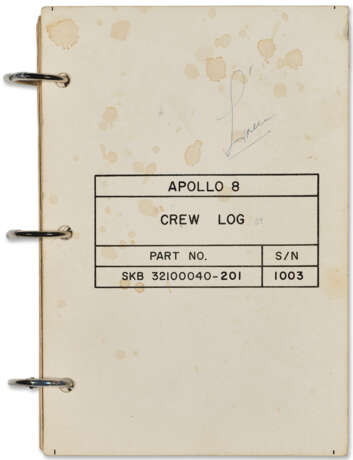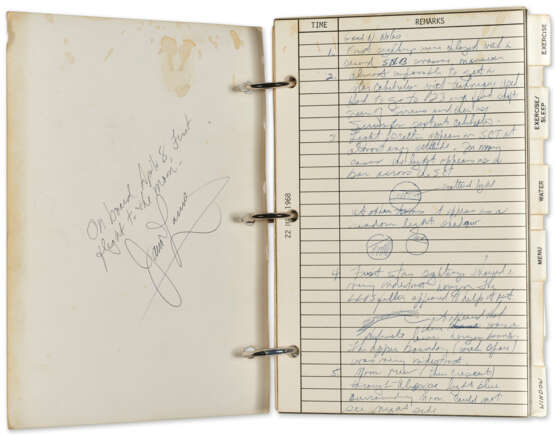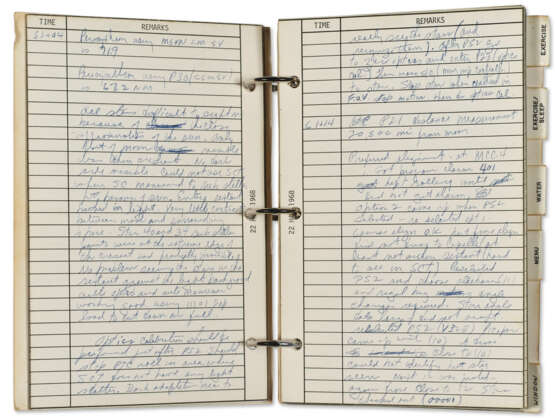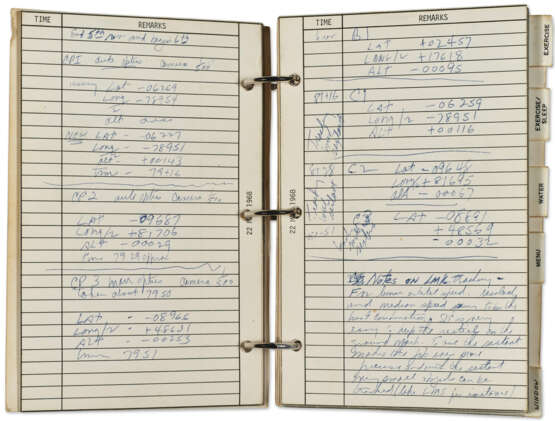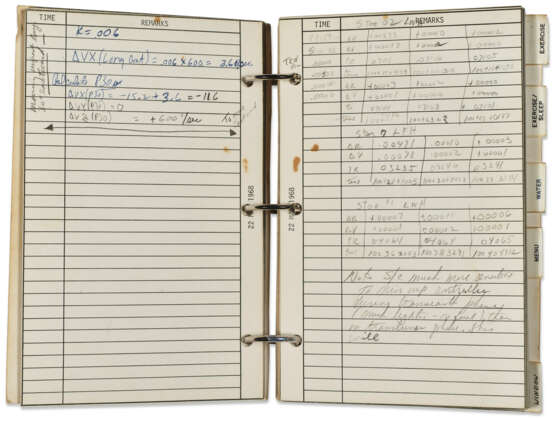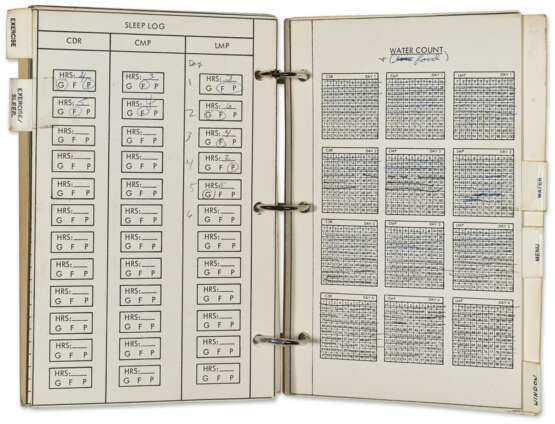ID 1279132
Лот 24 | FLOWN APOLLO 8 HANDWRITTEN CREW LOG
Оценочная стоимость
$ 60 000 – 80 000
JAMES LOVELL, DECEMBER 1968
48-page logbook, written on by Lovell during the flight, including descriptions, data, and checkmarks; plus about 35 leaves of blank printed templates, five index tabs; fastened with three metal book rings between two card covers. The front cover is titled: Apollo 8 / Crew Log / Part No. SKB 32100040-201 / SN 1003. Signed “Lovell” on the front cover and signed and inscribed on the inside front cover: “On board Apollo 8, First Flight to the Moon— / James Lovell.”
The pilot’s annotated log book from humanity’s first trip to the Moon. It was on this Christmas-time mission that human beings first entered the gravitational pull of another heavenly body and that William Anders took the iconic “Earthrise” photograph.
A trip to the Moon is nearly 240,000 miles. The crew members of Apollo 8—Frank Borman, James Lovell and William Anders—were the first humans to traverse this great distance. They circled the Moon ten times on Christmas Eve and Christmas Day in 1968 and witnessed the sight of our home planet rising above the Moon’s horizon. It was the first time that people saw the Earth from outer space, and in color. It was a profoundly moving image of peace and vulnerability that came at the close of a very turbulent year in American history.
James Lovell was the Command Module Pilot on Apollo 8 and later remarked that, for him, this mission was the equivalent of a mini Lewis & Clark expedition—in this case the new territory was the far side of the Moon. Of the launch day itself he said, “Suddenly I realized—I’m actually going to the Moon. All that navigational training I had was for real!” (from Lovell’s speech at the National Air and Space Museum's “Spirit of Apollo” event, 2018).
In this logbook, the navigational training that enabled Lovell to pilot to the Moon is in full display. The first page is headed “G and N Notes” for Guidance and Navigation. He wrote: “Almost impossible to get a star calibration with technique used. Had to go to P23... and then use Sirius for sextant calibration.” P23 was a program used to calculate cislunar distance, in combination with star readings. Lovell was an exemplary navigator and his readings were legendarily good—nearly as accurate as those from Mission Control.
Several pages later, at GET (ground elapsed mission time) 53:04 he gives some details on the difficulty of navigation as they approached the Moon: "Note. All stars difficult to sight on because of the close approximation of the sun. Only front of moon visible was then crescent. No dark side visible … Entry sextant bathed in light. Very little contrast between moon and surrounding space. Star 40 and 23 sub stellar points were at the extreme edge of the crescent and practically invisible … Optics calibration should be performed just after P52. Should stop PTC roll in area where SCT does not have any light scatter. Dark [??] to really see the stars (and recognize them). After P52 go to zero optics and enter P23 (optics cal[ibration]).”
At GET 61:14, Lovell notes that they are now just 20,500 miles from the Moon. They are a few hours from the critical juncture of reaching the pericynthion and having to decide whether to do nothing and slingshot around the Moon and return to Earth, or to slow the spacecraft down and allow it to enter the Moon’s orbit. Lovell closes this section, “Basic problem is the lack of ability to identify stars in the sextant. Not enough light transmission and too much light scattering. Have to rely much on good platform—”
The next entry is made just before GET 77:33, on Christmas Eve, while in lunar orbit. The Earthrise photograph has been taken and another major navigational exercise for Jim Lovell has begun. As they move to the far side of the Moon, Lovell has been tasked to sight “Control Point 2,” near crater Keeler. On this page and several following are his logged data for not only Control Point 2, but also Points 1 and 3. “Up to this time, much of the Moon's far side had been photographed by the Lunar Orbiter probes though the photography provided could not allow accurate determination of positions of surface features. Jim will use the computer to approximately aim the optics at the landmark. He will then aim them accurately and take marks” (NASA Apollo Flight Journal). We see the record of this and Lovell dividing the longitude by two so that the limited range of the computer can deal with it to the required precision.
The remaining notes are primarily star readings from the homeward journey, but towards the end he notes: “Moon washes out stars around it. Before moon came into view in SCT, many stars could be seen (black background). Example the guard stars in Apollo[?] were visible ... The Pleiades were visible although individual stars were hard to see.” The data logs at the very end of the logbook offer more prosaic, but still fascinating, details. The chicken and gravy Lovell ate on launch day was “salty” but the shrimp cocktail he consumed while circling the Moon was “great!”
8 x 5 ½ in. (20.3 x 14 cm.)
Provenance
James Lovell (b.1928); Heritage Auctions, Dallas, 8 October 2009, lot 41055.
Acquired at the above sale by the late owner.
| Категория аукционного дома: | Письма, документы и рукописи, Книги и рукописи |
|---|
| Категория аукционного дома: | Письма, документы и рукописи, Книги и рукописи |
|---|
| Адрес торгов |
CHRISTIE'S 8 King Street, St. James's SW1Y 6QT London Великобритания | |
|---|---|---|
| Предосмотр |
| |
| Телефон | +44 (0)20 7839 9060 | |
| Комиссия | see on Website | |
| Условия использования | Условия использования |
